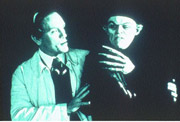THIS IS NOT a vampire movie, at least not in the traditional sense as inhabited by Klaus Kinski, Bela Lugosi, or even Tom Cruise. Shadow of the Vampire begins with the oft-told tale of Dracula, but fuses it with another equally familiar legend, that of the self-important Artist. In this case, the pompous, power-mad creator is a very fictionalized version of F.W. Murnau, the German director of the 1922 silent classic Nosferatu.
SHADOW OF THE VAMPIRE
directed by E. Elias Merhige with John Malkovich, Willem Dafoe, Eddie Izzard, and Catherine McCormack opens January 26 at Guild 45, Meridian, and others
In John Malkovich’s performance, Murnau is a cantankerous visionary who spouts lofty ideals about his work while sacrificing his cast and crew for the completion of his masterpiece. He turns out to be Shadow‘s true villain, making for an amusing, if hyperbolic, portrait of the filmmaker as bloodsucker.
While Shadow recreates several scenes from Nosferatu in detail, splicing original footage into a new context, the story itself is a radical departure from fact. It’s an uneven seriocomic tribute that poses that Max Schreck (Willem Dafoe), the physically grotesque actor who played Nosferatu, was indeed the real deal, a mountain recluse thirsty for human blood.
Dafoe appears to be having a ball portraying this cursed character: He hisses, bares pronged teeth, snacks on bats, and clicks razorlike fingernails like castanets. Even if you didn’t know that the gaunt, ghostlike Schreck was a professional actor who went on to perform 20 subsequent movie roles into the mid-’30s, Dafoe’s incarnation comes across as more comic than creepy.
SO WHAT’S THIS undead figure doing on a movie set? Seeking authenticity in the role of Nosferatu, Murnau has baited Schreck with his lead starlet Greta Schroeder (Braveheart‘s Catherine McCormack), a milky-skinned stage actress who portentously complains that the camera “sucks the life out of you.” (Also on hand is English comic Eddie Izzard as her baffled costar.) Meanwhile, the director keeps his entire crew in the dark, maintaining that Schreck is the ultimate method actor who can only be filmed at night in full Dracula makeup. Murnau’s ruse—and sanity—wears thin as the corpses pile up. The irony, of course, is that while the genius filmmaker promises immortality to his stars, he delivers them to their graves one by one.
Don’t expect to be scared by Shadow. Watch it for Dafoe’s giddy performance or for Malkovich losing his cool for once. Although Murnau is depicted at times with film student-like ardor (the artist figure raised to the level of a demigod), Shadow‘s premise also requires reducing him to the level of a monster. Playing the director during his crazed moments, Malkovich is all explosions and rants, screaming at the rapacious vampire to “control yourself.” However, the buildup to his eruptions is absent, making the volatile codependency between director and actor unconvincing.
As a musing on the nexus between life and art, Shadow falls short of last year’s Nurse Betty by Neil LaBute, a more comical and complex examination of that same topic. And while it’s also strongly reminiscent of Michael Powell’s 1960 Peeping Tom, about a dissociative serial killer-cameraman who films his victims as they’re murdered, Shadow unfortunately simplifies the real-life Murnau to a one-dimensional character, a man who’s fascinated—but finally confused—by his full-blooded actors and the scenes they enact through his lens. Although Shadow gives an interesting new perspective on the vampire myth, its most frightening aspect is the distortion of real historical figures.







